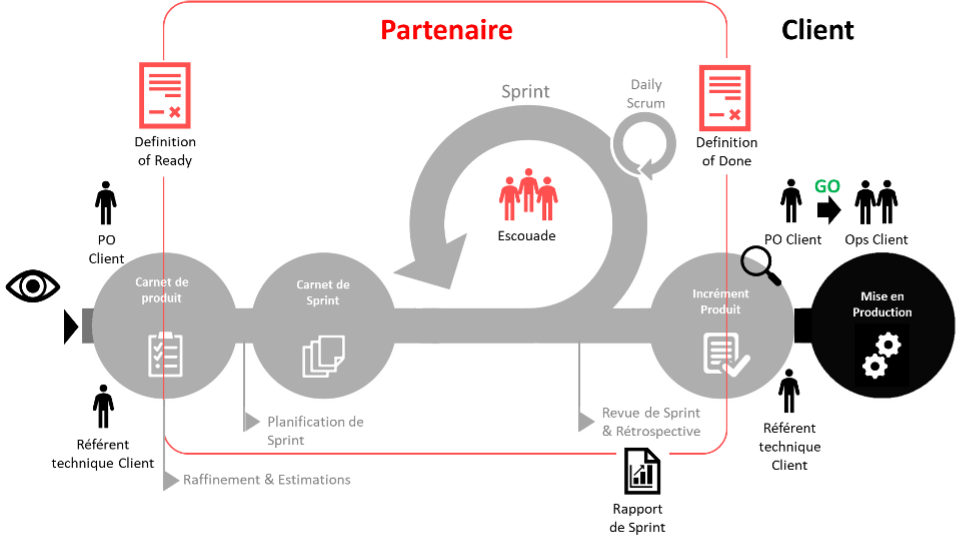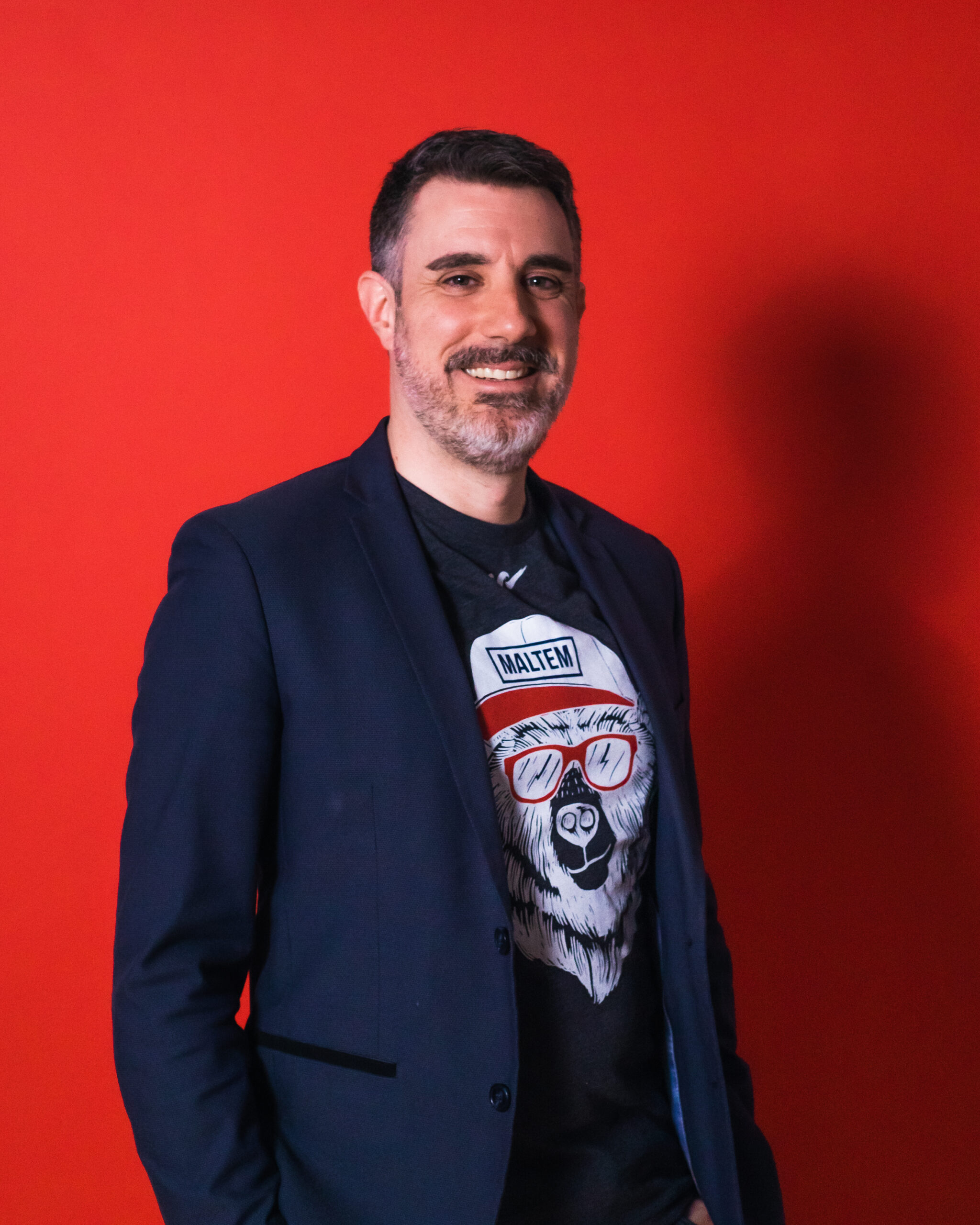What is an IT service center?
IT service centers are squads of experts mobilized to deliver IT services to a client. They can be located on the client premises or at the service provider’s, and are monitored by the service provider.
What does a service center do? Here is a non-exhaustive list of IT services that can be offered by a service center:
- IT support and assistance service,
- Maintaining applications in operational condition,
- Implementation of IT projects,
- Software package integration,
- Quality assurance (non-regression tests, whether automated or not).
In this article, we’ll be looking at service centers specializing in agile IT projects involving development. ⬇️
IT service centers, in what context?
Service centers in Quebec: an emerging model
Outsourced service centers are a model widely used in Europe, but one that is still gaining ground here in Quebec. When they call on information technology (“IT”) consulting firms, Quebec companies more often use the traditional model of placing consultants to carry out their IT development projects.
Yet service centers offer many advantages from the customer’s point of view, which we’ll develop in the following sections. 💡
Controlling IT development costs has become a key issue today, enabling companies to continue offering their customers a high-quality digital experience, while remaining competitive. The current context can be all the more confusing for decision-makers, who must constantly adapt their digital strategy:
- Technologies are evolving rapidly,
- Cyber-attacks are multiplying, and cyber-criminals are discovering and exploiting new vulnerabilities every day,
- The blazing progress of AI is leading us to question the evolution of developer professions and the way they work.
That said, our firms need more than ever to focus on what’s strategic for them, namely, their core business 🫶 (rarely IT!), while delegating their IT developments to partners who are experts in this field.
Challenges faced by Quebec companies in managing their IT projects
In spite of this context, many projects involving IT developments unfortunately fail to deliver, or their results fall short of expectations, and confidence in partners erodes. Has this ever happened to you?
- Take, for example, the traditional placement model, where the partner provides expert consultants to reinforce the customer’s teams. Billing is on a “time and materials” basis, and the success of the project rests entirely on the customer’s shoulders.
- Or a more binding model for the partner, such as a fixed price or project mandate: 100% of the project is entrusted to the partner, with payment on receipt of deliverables. In this case, things can sometimes get complicated towards the end of the deadline: given that any delay can involve penalties, a blame game can set in between the customer and his partner. The partner challenges the customer’s feedback and, if the customer wishes to change a line in the specifications, the partner revises the project cost upwards. In short, the customer gradually loses control over his project, and sometimes even, in the most unfavorable cases, legal departments find themselves involved.
So how do you recreate this trust between customer and IT partner?
Is there another model where the partner commits to delivering value alongside the customer, unlike the investment model, while providing more flexibility and agility than the fixed-price model?
The service center is a good example. 👇
How do IT development service centers work?
IT development service centers are made up of one or more multi-disciplinary IT teams , in the agile sense of the term, and therefore capable of taking charge of the realization of functionalities from A to Z, and each made up of 5 to 9 members. These teams are called “squads”.
Each squad takes charge of all or part of the realization of a digital project or product, whatever its life cycle 📈 (delivery of the first version or additional functionalities, maintenance in operational condition, incident management, technological migration, etc.).
The partner will take care of the entire human resources management of squad members, from their recruitment and qualification to their departure and the management of knowledge transfers , including appraisal interviews and managerial follow-up.
The chosen operating mode is often Scrum, but can also be Kanban . In all cases, the teams will adapt to the agile operating mode already in place at the customer’s site.
For digital projects or products whose size exceeds the capacity of a single agile squad, the model for distributing work between squads can be as follows grouping of functionalities belonging to the same domain (this is known as afeature teams“), by persona (“persona teams“), by user path (“user-journey teams“) or by objective (“impact teams”).
The diagram below summarizes this operating mode:

Here’s the typical composition of a service center squad:
- Each team must have a dedicated Product Owner (PO). His role will be that of a traditional PO: defining and communicating the product vision, deciding on priorities, updating the product backlog and validating increments. It is strongly recommended that this PO be an employee of the customer who has mastered the business domain related to the digital product. If the designated employee doesn’t have agile skills, the partner can always offer to support this person so that he or she can progressively take on the role of PO, and position a proxy-PO* as back-up in the meantime.
- The Scrum Master can be brought in by the partner. He will be responsible for ensuring the application of Agile practices in the team, continuous improvement, and for communicating performance indicators as well as Sprint reports and dashboards to the customer.
- The other members of the squad are technical experts in their field: developers, functional analysts, quality assurance analysts, automation specialists, and so on. In short, the partner must have all the necessary skills to be able to carry out the project.
- It is also advisable to have a technical contact on the customer side, whose role will be to define non-functional requirements, communicate them to the team and ensure that the delivered code meets the quality standards defined by the customer.
The increments produced will then be jointly inspected by the PO and the technical referent. Their validation may trigger the deployment of a new version of the product on production environments, either by an Infrastructure team positioned at the customer’s site, or by the squad if this falls within their scope of responsibility.
*Proxy-PO: Person who acts as an intermediary between the PO, who makes decisions about the product, and the production team. It performs activities that are usually carried out by the PO, such as gathering requirements, defining and scheduling the product backlog, etc. This role is not encouraged by agile approaches, but it can work on a temporary basis, while PO builds up its skills in this role.
What are the key success factors for service centers?
For a service center to function optimally and ensure your success, there are certain basic elements to put in place from the outset.
First of all, it is advisable to position a Service Center Referent at the partner’s site, who will be the customer’s single point of contact for any questions or requests relating to the management or operation of the service center. This person must not interfere with the collaboration between the customer’s Product Owner and the team members.
At the start of the collaboration, it is necessary to plan a calibration phase invoiced on a time-and-materials basis, before activating a stronger commitment mode. During this phase, measurements will be taken (such as average squad velocity) and work and collaboration processes between customer and partner will be adjusted.
The implementation of performance indicators by the partner and making them accessible to the customer is also a key success factor, as it will promote transparency and thus have a significant impact on customer confidence.
We also need to ensure that the customer and partner agree on what they consider to be a product backlog item that is ready to be taken over by a squad, as well as a finished item, ready to be presented to users.
Finally, it’s important to set up the right communication structures at the right levels:
- Firstly, at squad level: by ensuring that their members can communicate directly with the customer’s stakeholders (and even end-users).
- Then at the level of the Project Manager and/or Product Owner on the customer side, and the Service Center Manager and Scrum Masters on the partner side: they can meet periodically in a project committee to discuss priorities, risks and areas for improvement.
- Finally, at management level on the customer side , and the Account Manager and Service Center Manager on the partner side, they can meet in a steering committee to discuss the overall satisfaction of both parties, monitor commitments and deal with escalated issues.
What are the concrete benefits for you, the customer? ⭐️
First of all, there are several commitment models that partners can offer their customers:
- Commitment to velocity,
- Commitment to the content of the product logbook (more akin to the fixed-price model, but with the possibility of replacing items along the way with others, as long as the overall estimate of complexity remains the same),
- Commitment to deliverables.
All these models have their benefits, and some are better adapted to different project or customer organization contexts.
In addition to the commitment mode, here are a few other major advantages for the customer:
- Possibility of delegating the entire project lifecycle (design, development, maintenance, incident management, etc.),
- Reduced management of IT human resources (squads are handled 100% by the partner),
- Knowledge management in squads also managed by the partner (creation of a knowledge base, transfers between members, integration of new arrivals, etc.),
- Adapting the size and structure of the service center to fluctuations in the customer’s business, in a fast-changing market environment,
- Greater flexibility than a fixed-price model for product management (customer can modify the product logbook as he goes along),
- Transparency and control through measurement (thanks to key performance indicators and dashboards) to enable customers to make the best decisions,
- Access to rare technological expertise
- Access to low-cost technological expertise (through offshoring or relocation abroad, for example), if the partner has sufficient critical mass.
Conclusion
As we’ve explained, service centers are now a model that has proved its worth in other countries, and which offers a number of advantages over more traditional models. And you know what? They can be adapted to any sector of activity, whether you’re in finance or aeronautics.
How about helping you get started?
At maltem, we have extensive experience in setting up service centers for our customers, both here in Quebec and internationally 🌍. maltem canada can help you set up your own service center, for agile and efficient management of your digital projects and products.
If you are interested and/or would like to find out more about this subject, please do not hesitate to contact us. If you prefer to chat, my LinkedIn is also open to you 😉 .
We look forward to seeing you in a future article!

